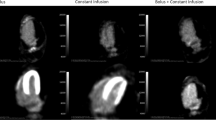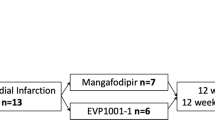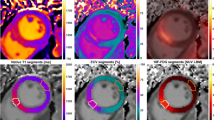Abstract
Background
Following myocardial infarction, tissue undergoes pathophysiological changes involving inflammation and scar tissue formation. However, little is known about the pathophysiology and prognostic significance of any corresponding changes in remote myocardium. The aim of this study was to investigate the potential application of a combined constant infusion of 18F-FDG and Gd-DTPA to quantitate inflammation and extracellular volume (ECV) from 3 to 40 days after myocardial infarction.
Methods
Eight canine subjects were imaged at multiple time points following induction of an MI with a 60-minute concurrent constant infusion of Gd-DTPA and 18F-FDG using a hybrid PET/MRI scanner.
Results
There was a significant increase in ECV in remote myocardium on day 14 post-MI (P = .034) and day 21 (P = .021) compared to the baseline. ECV was significantly elevated in the infarcted myocardium compared to remote myocardium at all time points post-MI (days 3, 7, 14, 21, and 40) (P < .001) while glucose uptake was also increased within the infarct on days 3, 7, 14, and 21 but not 40.
Conclusions
The significant increase in ECV in remote tissue may be due to an ongoing inflammatory process in the early weeks post-infarct.










Similar content being viewed by others
Abbreviations
- IOT:
-
Infarcted obstructed tissue
- INOT:
-
Infarcted not obstructed tissue
- RT:
-
Remote tissue
- MI:
-
Myocardial infarction
- GBCA:
-
Gadolinium-based contrast agent
- FDG:
-
18F-Fluorodeoxyglucose
- ECV:
-
Extracellular volume
- EF:
-
Ejection fraction
- ESV:
-
End-systolic volume
- EDV:
-
End-diastolic volume
References
Braunwald E. Research advances in heart failure: A compendium. Circ Res 2013;113:633-45. https://doi.org/10.1161/CIRCRESAHA.113.302254.
Eitel I, Kubusch K, Strohm O, Desch S, Mikami Y, De Waha S, et al. Prognostic value and determinants of a hypointense infarct core in T2-weighted cardiac magnetic resonance in acute reperfused ST-elevation- myocardial infarction. Circ Cardiovasc Imaging 2011;4:354-62. https://doi.org/10.1161/CIRCIMAGING.110.960500.
Pfeffer MA, Braunwald E. Ventricular remodeling after myocardial infarction: Experimental observations and clinical implications. Circulation 1990;81:116-72. https://doi.org/10.1161/01.CIR.81.4.1161.
Ganame J, Messalli G, Dymarkowski S, Rademakers FE, Desmet W, Van De Werf F, et al. Impact of myocardial haemorrhage on left ventricular function and remodelling in patients with reperfused acute myocardial infarction. Eur Heart J 2009;30:1440-9. https://doi.org/10.1093/eurheartj/ehp093.
Kim RJ, Wu E, Rafael A, Chen EL, Parker MA, Simonetti O, et al. The use of contrast-enhanced magnetic resonance imaging to identify reversible myocardial dysfunction. N Engl J Med 2000. https://doi.org/10.1056/NEJM200011163432003.
Biesbroek PS, Amier RP, Teunissen PFA, Hofman MBM, Robbers LFHJ, van de Ven PM, et al. Changes in remote myocardial tissue after acute myocardial infarction and its relation to cardiac remodeling: A CMR T1 mapping study. PLoS ONE 2017. https://doi.org/10.1371/journal.pone.0180115.
Lurz JA, Luecke C, Lang D, Besler C, Rommel KP, Klingel K, et al. CMR–derived extracellular volume fraction as a marker for myocardial fibrosis: The importance of coexisting myocardial Inflammation. JACC Cardiovasc Imaging 2018. https://doi.org/10.1016/j.jcmg.2017.01.025.
Cleutjens JPM, Verluyten MJA, Smits JFM, Daemen MJAP. Collagen remodeling after myocardial infarction in the rat heart. Am J Pathol 1995.
Radenkovic D, Weingärtner S, Ricketts L, Moon JC, Captur G. T1 mapping in cardiac MRI. Heart Fail Rev 2017. https://doi.org/10.1007/s10741-017-9627-2.
Thornhill RE, Prato FS, Wisenberg G, Moran GR, Sykes J. Determining the extent to which delayed-enhancement images reflect the partition-coefficient of Gd-DTPA in canine studies of reperfused and unreperfused myocardial infarction. Magn Reson Med 2004. https://doi.org/10.1002/mrm.20236.
Salerno M, Janardhanan R, Jiji RS, Brooks J, Adenaw N, Mehta B, et al. Comparison of methods for determining the partition coefficient of gadolinium in the myocardium using T1 mapping. J Magn Reson Imaging 2013. https://doi.org/10.1002/jmri.23875.
Diesbourg LD, Prato FS, Wisenberg G, Drost DJ, Marshall TP, Carroll SE, et al. Quantification of myocardial blood flow and extracellular volumes using a bolus injection of Gd-DTPA: Kinetic modeling in canine ischemic disease. Magn Reson Med 1992;23:239-53. https://doi.org/10.1002/mrm.1910230205.
Smailovic H, Wilk B, Wisenberg G, Sykes J, Butler J, Hicks JW, et al. Simultaneous measurements of myocardial glucose metabolism and extracellular volumes with hybrid PET/MRI using concurrent injections of Gd-DTPA and [18F]FDG. Submitt to J Nucl Cardiol 2020.
Larson SR, Pieper JA, Hulten EA, Ficaro EP, Corbett JR, Murthy VL, et al. Characterization of a highly effective preparation for suppression of myocardial glucose utilization. J Nucl Cardiol 2019. https://doi.org/10.1007/s12350-019-01786-w.
Merten CL, Knitelius HO, Assheuer J, Bergmann-Kurz B, Hedde JP, Bewermeyer H. MRI of acute cerebral infarcts: Increased contrast enhancement with continuous infusion of gadolinium. Neuroradiology 1999. https://doi.org/10.1007/s002340050740.
Prato FS, Butler J, Sykes J, Keenliside L, Blackwood KJ, Thompson RT, et al. Can the inflammatory response be evaluated using 18F-FDG within zones of microvascular obstruction after myocardial infarction? J Nucl Med 2015;56:299-304. https://doi.org/10.2967/jnumed.114.147835.
Lau JMC, Laforest R, Sotoudeh H, Nie X, Sharma S, McConathy J, et al. Evaluation of attenuation correction in cardiac PET using PET/MR. J Nucl Cardiol 2017;24:839-46. https://doi.org/10.1007/s12350-015-0197-1.
Patlak CS, Blasberg RG, Fenstermacher JD. Graphical evaluation of blood-to-brain transfer constants from multiple-time uptake data. J Cereb Blood Flow Metab 1983;3:1-7. https://doi.org/10.1038/jcbfm.1985.87.
Lawrence J, Chang YMR, Szladovits B, Davison LJ, Garden OA. Breed-specific hematological phenotypes in the dog: A natural resource for the genetic dissection of hematological parameters in a mammalian species. PLoS ONE 2013. https://doi.org/10.1371/journal.pone.0081288.
Higgins PJ, Garlick RL, Bunn HF. Glycosylated hemoglobin in human and animal red cells. Role of glucose permeability. Diabetes 1982. https://doi.org/10.2337/diab.31.9.743.
Lortie M, Beanlands RSB, Yoshinaga K, Klein R, DaSilva JN, DeKemp RA. Quantification of myocardial blood flow with 82Rb dynamic PET imaging. Eur J Nucl Med Mol Imaging 2007;34:1765-74. https://doi.org/10.1007/s00259-007-0478-2.
Anazodo U, Kewin M, Finger E, Thiessen J, Hadway J, Butler J, et al. Preliminary evaluation of MRI-derived input function for quantitative measurement of glucose metabolism in an integrated PET-MRI. EJNMMI Phys 2015;2:1-2. https://doi.org/10.1186/2197-7364-2-s1-a80.
White SK, Sado DM, Fontana M, Banypersad SM, Maestrini V, Flett AS, et al. T1 mapping for myocardial extracellular volume measurement by CMR. JACC Cardiovasc Imaging 2013. https://doi.org/10.1016/j.jcmg.2013.01.011.
Fedorov A, Beichel R, Kalpathy-Cramer J, Finet J, Fillion-Robin JC, Pujol S, et al. 3D Slicer as an image computing platform for the Quantitative Imaging Network. Magn Reson Imaging 2012. https://doi.org/10.1016/j.mri.2012.05.001.
Bekkers SCAM, Yazdani SK, Virmani R, Waltenberger J. Microvascular obstruction. Underlying pathophysiology and clinical diagnosis. J Am Coll Cardiol 2010. https://doi.org/10.1016/j.jacc.2009.12.037.
Borchert T, Beitar L, Langer LBN, Polyak A, Wester H-J, Ross TL, et al. Dissecting the target leukocyte subpopulations of clinically relevant inflammation radiopharmaceuticals. J Nucl Cardiol 2019.
Chew DS, Heikki H, Schmidt G, Kavanagh KM, Dommasch M, Bloch Thomsen PE, et al. Change in left ventricular ejection fraction following first myocardial infarction and outcome. JACC Clin Electrophysiol 2018. https://doi.org/10.1016/j.jacep.2017.12.015.
Sun Y, Cleutjens JPM, Diaz-Arias AA, Weber KT. Cardiac angiotensin converting enzyme and myocardial fibrosis in the rat. Cardiovasc Res 1994. https://doi.org/10.1093/cvr/28.9.1423.
Kidambi A, Motwani M, Uddin A, Ripley DP, McDiarmid AK, Swoboda PP, et al. Myocardial extracellular volume estimation by CMR predicts functional recovery following acute MI. JACC Cardiovasc Imaging 2017. https://doi.org/10.1016/j.jcmg.2016.06.015.
Thornhill RE, Prato FS, Wisenberg G, White JA, Nowell J, Sauer A. Feasibility of the single-bolus strategy for measuring the partition coefficient of Gd-DTPA in patients with myocardial infarction: Independence of image delay time and maturity of scar. Magn Reson Med 2006. https://doi.org/10.1002/mrm.20830.
Haaf P, Garg P, Messroghli DR, Broadbent DA, Greenwood JP, Plein S. Cardiac T1 mapping and extracellular volume (ECV) in clinical practice: A comprehensive review. J Cardiovasc Magn Reson 2016. https://doi.org/10.1186/s12968-016-0308-4.
Hinderer S, Schenke-Layland K. Cardiac fibrosis—A short review of causes and therapeutic strategies. Adv Drug Deliv Rev 2019. https://doi.org/10.1016/j.addr.2019.05.011.
Herrero P. Quantification of myocardial glucose utilization by PET and 1-carbon-11-glucose. J Nucl Cardiol 2002;9:5-14. https://doi.org/10.1067/mnc.2001.120635.
Acknowledgements
Wilk, B. is supported by an Ontario Graduate scholarship and a Lawson Internal Research Fund. This work was supported in part by Ontario Research Fund RE7-021 and Canadian Foundation for Innovation no. 11358. The authors would like to thank Siemens Health Care Limited for the in-kind contribution of the Myomaps software license. Both first authors contributed equally to this work.
Disclosure
B. Wilk, H. Smailovic, G. Wisenberg, J. Sykes, J. Butler, M. Kovacs, J. D. Thiessen, and F. S. Prato have no conflicts of interest to disclose.
Author information
Authors and Affiliations
Corresponding author
Additional information
Publisher's Note
Springer Nature remains neutral with regard to jurisdictional claims in published maps and institutional affiliations.
The authors of this article have provided a PowerPoint file, available for download at SpringerLink, which summarizes the contents of the paper and is free for re-use at meetings and presentations. Search for the article DOI on SpringerLink.com.
The authors have also provided an audio summary of the article, which is available to download as ESM, or to listen to via the JNC/ASNC Podcast.
Supplementary information
Below is the link to the electronic supplementary material.
Rights and permissions
About this article
Cite this article
Wilk, B., Smailovic, H., Wisenberg, G. et al. Tracking the progress of inflammation with PET/MRI in a canine model of myocardial infarction. J. Nucl. Cardiol. 29, 1315–1325 (2022). https://doi.org/10.1007/s12350-020-02487-5
Received:
Accepted:
Published:
Issue Date:
DOI: https://doi.org/10.1007/s12350-020-02487-5




